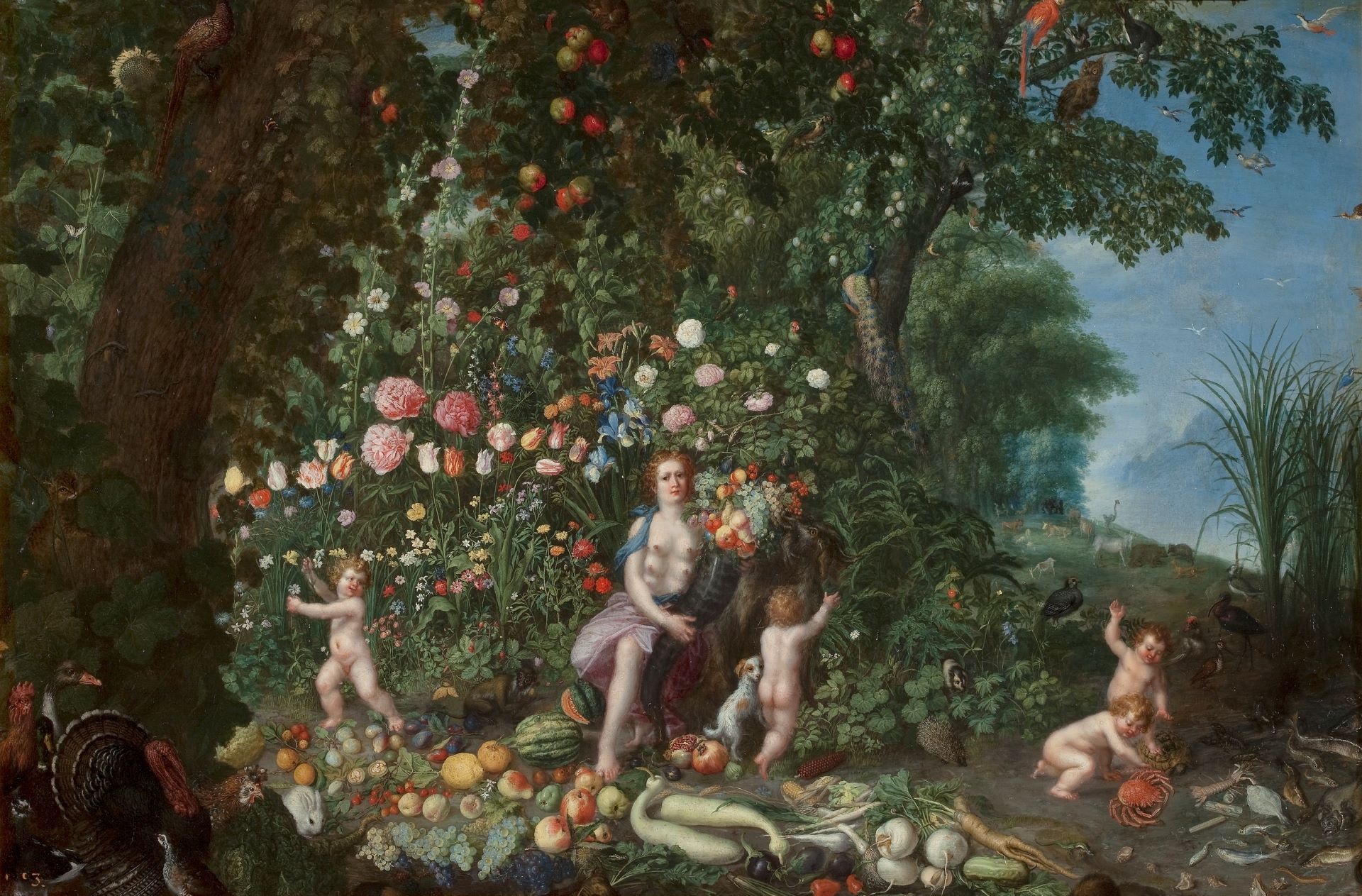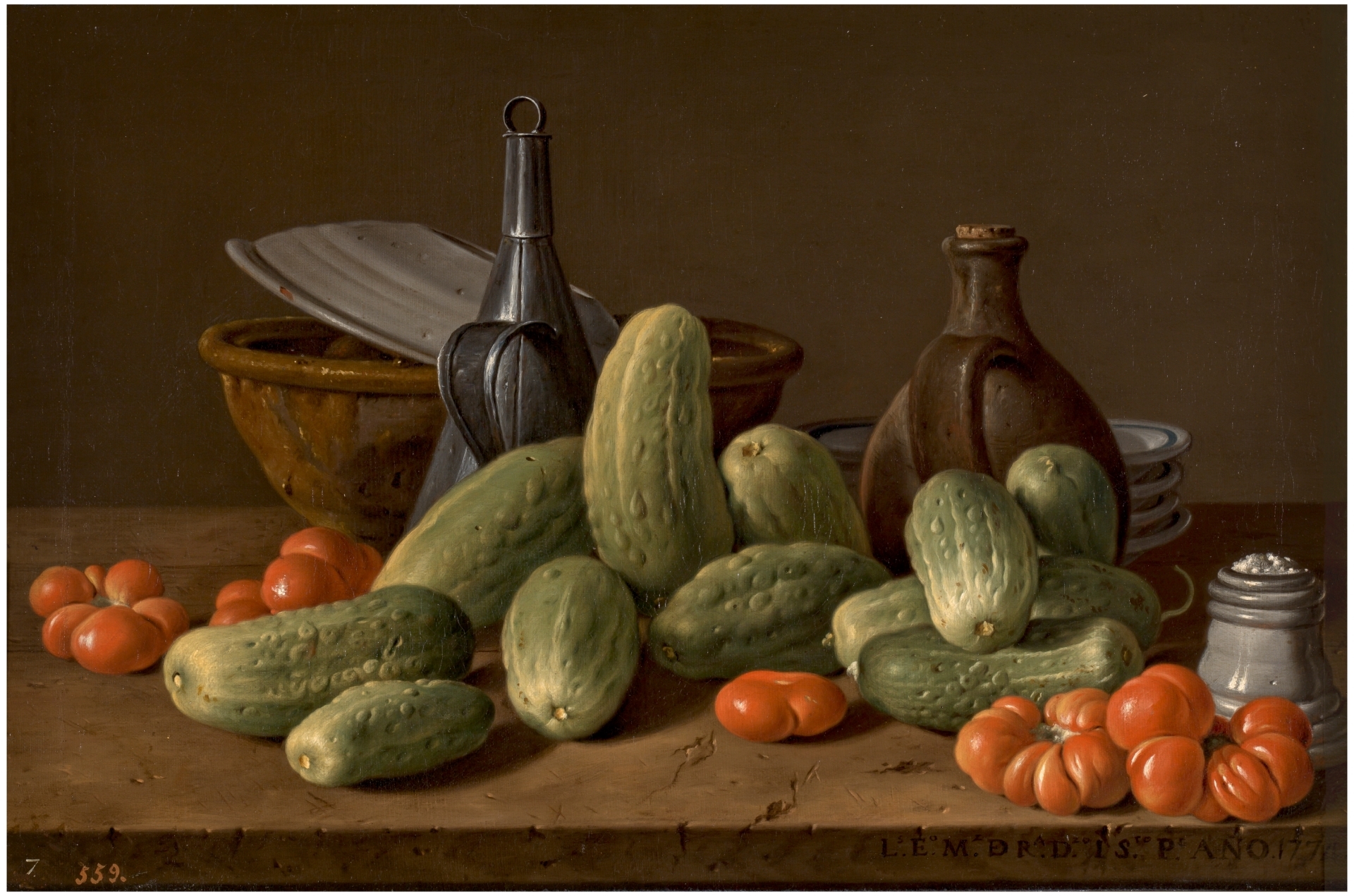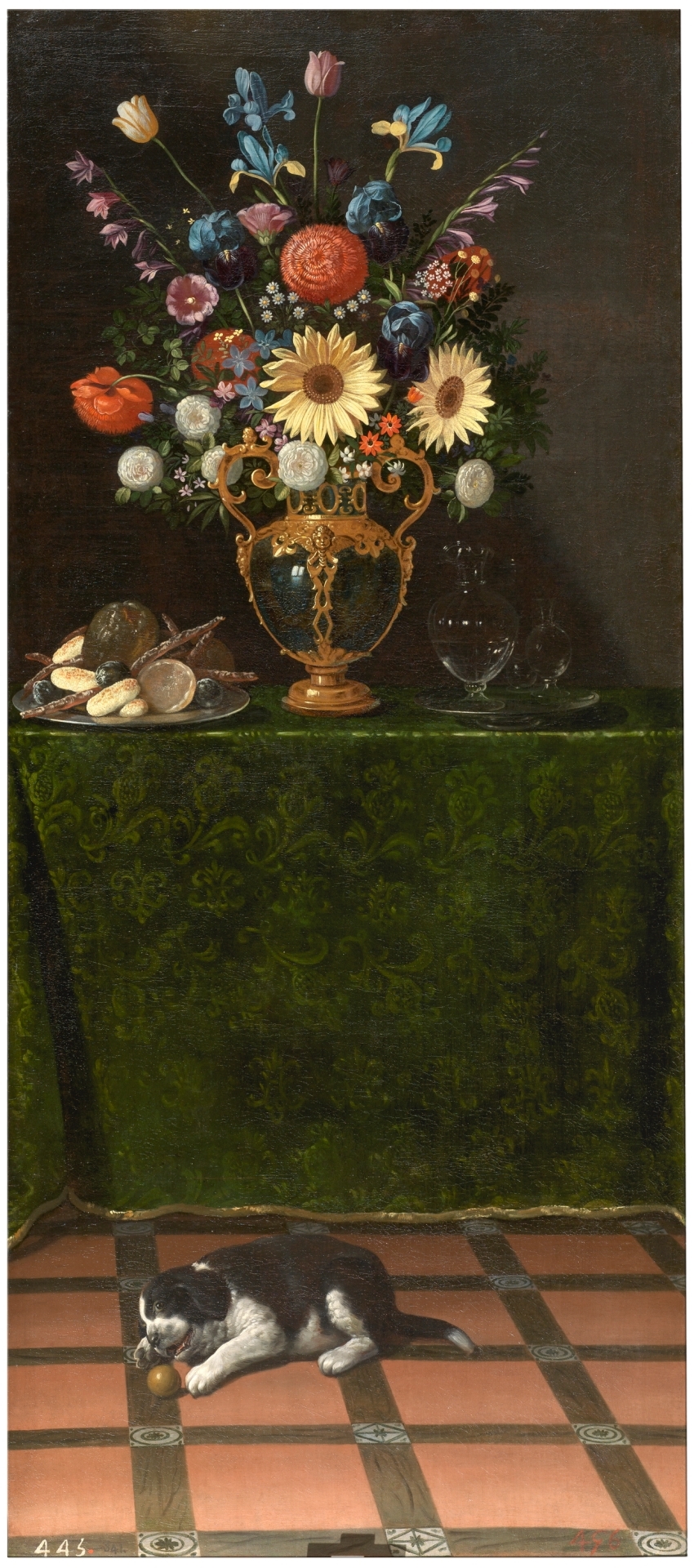
“Inconita et non peiu visto”: American flora in the Museo del Prado collections
The first impression that Europeans had upon arriving in America was that of exuberant nature, plenty of plants and animals whose forms were hardly comparable to those of known nature. Christopher Columbus himself demonstrated this with the peculiar selection of specimens he brought back from his first voyage to show to the Catholic Monarchs of Spain. Among them were some crops that would forever change the European diet, such as chili peppers and maize. The impact of these new plants in nutrition across Europe and their economic potential explain why, just a few years later, dozens of crops reached the Old World, destined to improve the diet of Europeans or simply to beautify the gardens of the different courts throughout Europe.
Given their striking presence in orchards and gardens, it was inevitable that these exotic plants would capture the attention of artists and that, very quickly in some cases, they would decide to include them in their variegated compositions. Some cases are particularly striking, as artists were decades ahead of the representation of some plants with respect to botanical books and scientific engravings. This is the case of the American cucurbits or maize, which were represented as early as 1515 in the frescoes of the Villa Farnesina, several decades ahead of the first scientific representations in Leonhart Fuchs’ De historia stirpium commentarii insignes (1542).
In addition to frescoes, paintings made in the European Early Modern Age began to be populated with fruits and flowers of American origin, encouraged by the various pictorial genres developed at the time. As Jan Brueghel the Elder noted in one of his letters to his protector Carlo Borromeo, the new flora he could admire in the gardens of the Archduke of Austria, Albert, and the sovereign of the Spanish Netherlands in the Low Countries, Isabella Clara Eugenia, was “inconita e non peiu visto” (“Unknown and never seen before”). In addition to still lifes, we find American flowers and fruits in works of a religious, mythological or allegorical nature. With this, art not only documents the arrival and establishment of these crops but also offers us some ideas about the values and prejudices given to American plants and, by extension, to everything that came from the New World. A good example of the presence and connotations of these plants can be found in the rich representation of American plants, both edible and inedible, in the collections of the Museo del Prado in Madrid.
Within what we can call “edible flora”, the presence of food from America in the collections of the Museo del Prado is limited but significant. In total, four edible products from the Americas have been identified: pumpkin, maize, bell pepper and tomato. Quantitatively, the pumpkin stands out among the other products, with more than twenty representations. We find representations of Cucurbita pepo, Cucurbita moschata, Cucurbita maxima and Cucurbita argyrosperma in a great variety of contexts and genres. Thus, we find it prominent within allegorical contexts, especially linked to representations of natural generosity, as in Abundance by Jan Brueghel the Younger (ca. 1625), where about ten American species are also found (Figure 1). It also appears within the still life genre and in a wide variety of contexts, from Juan van der Hamen’s humble Still Life of Fruit and Vegetables (1625) to Van Utrecht’s opulent A Larder (1642). On a more ad hoc basis, the pumpkin also appears in mythological scenes, as in Frans Snyders and Peter Paul Rubens’s Ceres and Pan (ca. 1620).
The presence of other American edible vegetables is much more discreet than in the case of the pumpkin, but they help us to understand their different uses. An interesting case is that of the pepper (Capsicum annuum), whose appearance in the Prado collections is notably marked by the geographical origin of the works. Thus, if in the case of the representations from the Netherlands, they are found exclusively in allegorical contexts, as in The Paradise and the Four Elements (1606-1609) by Hendrik de Clerck and Denis Van Alsloot, while in the Spanish case, their context is exclusively domestic, as in Mateo Cerezo’s Kitchen still life (ca. 1664). Even more clear is the case of the tomato (Solanum lycopersicum), absent in the works from the Netherlands and whose only three examples are inserted in Spanish still lifes (“bodegones” in Spanish) or market scenes, already from the 18th century, as in Still Life with Cucumbers, Tomatoes and Vessels by Luis Meléndez (1774) (Figure 2).
Quite the opposite occurs with maize (Zea mays), a cereal totally absent in the Spanish art collection of the Museo del Prado. Its representation in this case is confined to the Netherlands and, again, it appears in various contexts, such as allegorical, in the aforementioned The Abundance; mythological, as in Three Nymphs with the Horn of Plety (1615-1617) by Peter Paul Rubens and Frans Snyders; or religious, as in The Virgin and Child in a Painting surrounded by Fruit and Flowers (1617-1620) by Rubens and Jan Brueghel the Elder.
Figure 2. Still Life with Cucumbers, Tomatoes and Vessels by Luis Meléndez (1774). Museo del Prado
The representation of non-edible plants
In addition to edible plants, the Prado collection contains interesting representations of non-edible plants from the Americas, especially flowers, some of which acquired a symbolic use, such as the passionflower or the sunflower. Of the flowers from the New World, a total of eight have been located in the paintings of the Spanish museum.
Quantitatively, the presence of the flower commonly known as “dondiego de día” [morning-glory] (Ipomoea purpurea), also known in Spanish as “manto de María” or “gloria de la mañana”, stands out. A total of fifty representations of this American flower have been located. The reference to the Virgin Mary in one of its popular names could be behind its representation in some Marian scenes, such as in The Virgin of Atocha (ca. 1680) by Juan Carreño de Miranda. For its part, its name “morning glory” could justify its presence in several portraits of children in the 18th and 19th centuries, as in Charles III as a Boy in his Study (ca. 1724) by Jean Ranc. But, undoubtedly, the pictorial genre in which this American species is most represented is in the genre of the still life of flowers, which accounts for thirty-three of these representations, eight of which belong to Bartolomé Pérez.
Along with the inclusion of the “dondiego de día”, the important presence of the “flor capuchina” [Indian cress] (Tropaeolum majus) stands out, with seventeen representations. In addition to its representation in still lifes of flowers, it is worth noting its presence in portraits of ladies, as in the anonymous 18th century Portrait of a Young Lady, and in religious or mythological works, as in Garland with the Virgin, Child, and Two Angels (ca. 1619) by Jan Brueghel the Elder and Giulio Cesare Procaccini or in Diana in a Landscape (1739) by Louis-Michel Van Loo.
“Tagetes” [Aztec marigold] (Tagetes erecta) and sunflowers (Helianthus annuus) make up a third group with six and five appearances respectively. Aztec marigold is represented exclusively in still lifes of flowers, but from various European areas: from Spain, as in Tomás Hiepes’ Vase of Flowers decorated with a Triumphal Chariot seen in profile (1643); from Italy, in two vases by Mario Nuzzi; or in the Netherlands, where the Aztec marigold appears in a Floral Still Life (mid-17th century) by Jan Van Kessel the Elder. In contrast, the representation of the sunflower is practically exclusive to Spanish artists, where it appears in different contexts, such as in still lifes of flowers (Still Life with Vase of Flowers and a Puppy by van der Hamen, 1625) (Figure 3); in Marian themes, as in Antonio Ponce’s Flower garland with the Assumption of Mary (1654), and even mythological, as in van der Hamen’s An Offering to Flora (1627).
One of the flowers that undoubtedly most attracted the attention of Europeans for its strange shape and its didactic potential, the passionflower (Passiflora incarnata), has, however, few representations in the Museo del Prado and always by Spanish artists. There are only three images, highlighting its link with the figure of Christ in the work Garland of flowers with St. Anthony of Padua (1689) by Bartolomé Pérez.
Figure 3. Still Life with Vase of Flowers and a Puppy by van der Hamen, 1625. Museo del Prado
Along with these American flowers and with a testimonial presence, we also find the Indian cane (Canna indica), with three representations; the Indian fig opuntia (Opuntia ficus-indica), but already in works of the 19th century; and the fuchsia (Fuchsia L.), represented only once in the Museo del Prado, in nineteenth-century still life.
Vanessa Quintanar Cabello is PhD in Art History by the Complutense University of Madrid. Specialist in the representation of exotic elements in European art, she is the author of the book “The Representation of American Foods in the Arts and Sciences of the European Modern Age (16th-18th centuries)”. She is currently a postdoctoral researcher in a stay at the University of Valladolid where she is conducting a study on the presence of American elements in the Spanish nobility of the 16th century. In addition, she is a member of the Recognized Research Group of the University of Valladolid “Art, Power and Society in the Modern Age”, directed by Dr. Miguel Ángel Zalama Rodríguez.




0 Comments